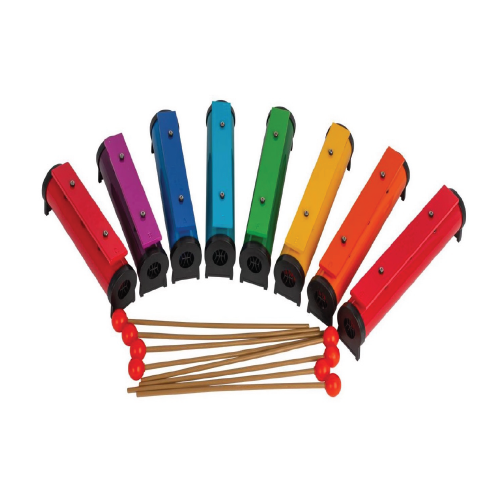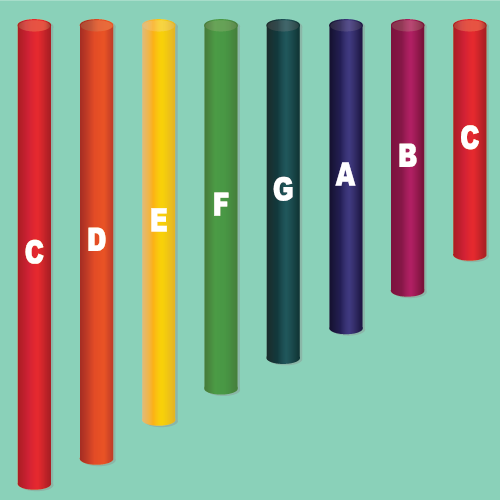
Prep. Lesson 16. Instrumental pitch mapping
- Boomwhackers, chime bars Difficulty:
 Prior learning: High and low sounds
Prior learning: High and low sounds
![]() Students will develop their ability to match pitch, understand the concept of an echo, and explore different vocal expressions.
Students will develop their ability to match pitch, understand the concept of an echo, and explore different vocal expressions.
![]() Lyrics
Lyrics
There's someone living on a big, high hill. I wonder who it could be.
There's someone living on a big, high hill who always answers me.
Yoo hoo, yoo hoo, he always answers me.
Yoo hoo, yoo hoo, he always answers me.
- Begin by singing, asking the students to echo each phrase at the same pitch.
- Ask the students what they think an echo is.
- Explain that an echo repeats what is heard, just like they are doing with their singing.
- Sing a phrase of the song using different vocal styles (e.g., whispering, loud, squeaky, deep).
- Have the students echo back in the same style.
- Ask them to notice how their voices change depending on the pitch and vocal style.
- Select a few students to take turns being the leader.
- Each leader sings a phrase using a chosen vocal style (e.g., high-pitched, robotic, monster voice).
- The rest of the class echoes the phrase in the same style.
- Select a student to sing a phrase using a voice of their choice. The rest of the class must discover the voice type used (e.g., whispering, shouting, soft).
- Rotate roles so multiple students get a chance to lead.
- Ask students: “What was your favourite voice to use?” and “Why is it important to match the pitch of the echo?”
- Praise their participation and creativity in exploring pitch and vocal expression.
 Success Criteria
Success Criteria
- I can echo a pitch accurately.
- I can identify and imitate different voices during the activity.
- I can participate actively by listening, singing, and choosing voices for others to guess.
![]()
Students will develop their ability to match pitch, dynamics, and movement through interactive body-based activities.
 Success Criteria
Success Criteria
- I can match pitch by moving my body up and down correctly.
- I can adjust the size of my movements to match the dynamics of the teacher’s voice.
- I can walk to the beat and respond accurately during the echoes

- Guide students to walk around the room in time with a steady beat.
- Model the beat vocally or use a percussion instrument to keep everyone coordinated.
- Call out echoes by singing phrases at various pitches.
- Have students stop walking and bob up or down to match the pitch: bend knees for lower sounds and stretch slightly upwards for higher sounds.
- Sing the echoes using different dynamics and voice types:
- Whisper voice: Students make small, quiet movements.
- Speaking voice: Students make larger movements.
- Emphasise matching the pitch even when dynamics change.
- Remind students that even if the voice type doesn’t have a clear pitch (e.g., whisper), they can match the pitch in their heads and still bob correctly.
- Encourage students to take turns being the leader.
- The leader sings an echo with a chosen voice type, and the class matches the pitch, dynamics, and movements.
![]() Students will play chime bars while connecting two sounds to the song Someone’s Living on a Big, High Hill.
Students will play chime bars while connecting two sounds to the song Someone’s Living on a Big, High Hill.

 Success Criteria
Success Criteria
- I can identify and handle the chime bars carefully.
- I can play the G and E chime bars accurately.
- I can connect the chime bars' sounds to the song's echo.
- Gather students in a circle and introduce the chime bars.
- Explain what a chime bar is, demonstrating how to hold and play it gently using the mallet.
- Emphasise the importance of handling the chime bars carefully to keep them in good condition.
- Ask each student to take a dark green chime (G) and a yellow chime (E).
- Demonstrate placing the chime bars on the floor or holding them securely while playing.
- Have students practise striking the G and E chime bars separately, focusing on producing a clear sound.
- Please encourage them to listen to the difference between the two pitches and ensure their mallet strikes are controlled.
- Play G and E alternately and ask students if they recognise the sound.
- Explain that these notes create the echo from the song Someone’s Living on a Big, High Hill.
- Sing the song as a group, stopping to play G and E as the echo after each phrase.
- Guide students to appropriately play the correct chime bar, reinforcing the connection between the song and the notes.
- Praise their efforts in handling the instruments carefully and matching the sounds accurately.
![]() Students will use Boomwhackers to represent pitch changes in the song "Here We Go Up," building on their understanding of high and low sounds.
Students will use Boomwhackers to represent pitch changes in the song "Here We Go Up," building on their understanding of high and low sounds.

- Remind students of the previous activity with beach balls, where they showed high and low sounds.
- Ask: “What were the beach balls representing in the song Here We Go Up?” [high and low sounds]
- Show the boomwhackers to the class and explain how to play them by holding the boomwhacker by the end and striking it gently on the floor or in your hand.
- Demonstrate the different lengths and their sounds.
- Give out long red, yellow, dark green, and short red boomwhackers.
- Organise the students into groups based on the boomwhacker colours and lengths.
- Arrange the groups in order of pitch, from the lowest (long red) to the highest (short red).
- As you point to a colour, those students play their boomwhacker.
- Practise this sequence several times until secure.
- Sing Here We Go Up as a group while students play their boomwhackers in the correct sequence.
- Repeat the song, removing the singing voices and asking students to use inner hearing to follow the melody, only audibly singing the middle section.
- Talk about the boomwhacker lengths and their corresponding sounds.
- Ask: “What do you notice about the boomwhacker's length and the sound's pitch?” (E.g., longer boomwhackers produce lower sounds, shorter boomwhackers produce higher sounds.)
- Praise students for their listening, coordination, and participation.
 Success Criteria
Success Criteria
- I can play my boomwhacker in the correct order when pointed to.
- I can connect the pitch changes in the song to the boomwhacker lengths.
- I can sing with inner hearing while playing the boomwhackers.
![]() Students will explore pitch by matching their body movements to the melody of On the Ground, developing pitch awareness and physical coordination.
Students will explore pitch by matching their body movements to the melody of On the Ground, developing pitch awareness and physical coordination.
![]() Lyrics
Lyrics
Here we go up, Here we go down,
Now we are spinning around and around.
Here we go up, Here we go down,
Now we are falling like leaves to the ground.
- Introduce On the Ground by singing it for the students.
- Have students listen carefully to the melody and lyrics.
- Sing the song again, encouraging students to join once they are familiar with the words.
- Teach how the body movements correspond to the pitch.
- For "Here we go up", students crouch low and gradually stand as the pitch rises.
- For "Here we go down", students stretch tall and drop to the floor as the pitch falls.
- For 'Now we are spinning', students twirl around in place.
- For 'Like leaves to the ground', students fall gently to the floor, imitating leaves.
- Sing the song together, guiding the students through the corresponding movements.
- Repeat the activity, ensuring students accurately match their body movements to the pitch and lyrics.
- Challenge the students to perform the movements without your guidance, relying on the lyrics and melody to guide their actions.
- Praise their efforts in matching the melody with their actions and reinforce the connection between sound and movement.
 Success Criteria
Success Criteria
- I can move my body to match the pitch of the song.
- I can coordinate my movements with the lyrics.
- I can participate actively in the activity, responding accurately to pitch changes.
![]() Students will explore pitch by playing chime bars to match the melody, observing the relationship between chime length and pitch, and developing coordination through singing and playing.
Students will explore pitch by playing chime bars to match the melody, observing the relationship between chime length and pitch, and developing coordination through singing and playing.
 Success Criteria
Success Criteria
- I can observe how the length of chime bars relates to pitch.
- I can glissando up and down the chime bars for "up" and "down."
- I can use inner hearing or sing while playing the chime bars.
- Begin by revisiting the boomwhacker activity. Ask students: “What did we notice about the lengths of the boomwhackers and how they relate to the pitch?”
- Reinforce that longer instruments produce lower pitches and shorter ones produce higher pitches.
- Distribute colourful chime bar sets to the students.
- Explain that they will play every note on the chime bars and observe how the chime's length affects the pitch.
- Encourage students to compare the lengths and sounds as they explore.
- Model playing the melody of the song, focusing on how the pitch rises and falls.
- Demonstrate a glissando down the chime bars for "down" by sliding the mallet smoothly across the bars in descending order.
- Show how to reverse the glissando for "up," moving from low to high notes.
- Allow students to practise playing individual notes and glissandos, ensuring they follow the pitch direction accurately.
- Sing the song while students play along, following the pitch changes.
- Extension: Transition to inner hearing: Ask students to sing the melody in their heads while playing the chime bars.
- Encourage students to sing aloud while simultaneously playing the chime bars, focusing on coordination and accuracy.
- Ask students: “What did you notice about the chime bar lengths and their pitch?”
- Praise their efforts in combining singing and instrumental playing.
Suggested lessons
Y1. Beat II

Y1. Beat III

Y1. Beat IV

